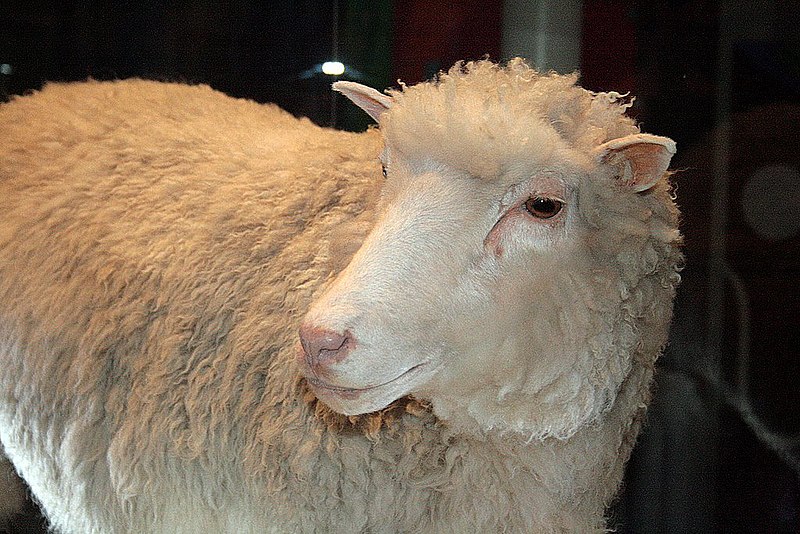Dolly the Sheep Cloned, 1996
 |
| Taxidermied Dolly ©Tom Barros/Wikimedia Commons |
Dolly had three mothers: one who provided the egg, another the DNA, and a third who carried her to term. The cell used as the donor was taken from the mammary gland of an adult sheep, and Dolly got her name as a tribute to Dolly Parton. Ian Wilmut, of the cloning team, said, "Dolly was cloned from a mammary gland cell, and we couldn't think of a more impressive pair of glands than Dolly Parton's." The experiment was also significant in that it proved that a complete animal could be cloned from a cell taken from a specific part of the body.
Dolly was a creation of a team at the Roslin Institute near Edinburgh, Scotland. The team was headed by Ian Wilmut. According to Wilmut, about 65% of the work on the project was done by Keith Campbell. She was born, strong and healthy, on July 5, 1996, but her birth was not announced until the following February, to allow for scientific publication.
Dolly the Sheep lived out her entire life at Roslin Institute. The plan was for her to have as normal a "sheep life" as possible. She was bred to a Welsh Mountain ram and produced, in total, six offspring. In 1998 she had a single lamb, Bonnie. In 1999, she produced twins, Sally and Rosie. The year after that she had triplets: Lucy, Darcy, and Cotton. She shared a pen with other sheep until some of the sheep contracted sheep pulmonary adenomatosis (SPA), an incurable disease caused by a virus that causes the growth of tumors in the lungs. After that, Dolly was placed in isolation.
When one of Dolly's twin lambs was diagnosed with SPA, it was determined that Dolly almost certainly had it also, and there was no reason to keep her isolated. She was checked by a veterinarian daily, and remained healthy until February, 2003, when she was noticed coughing. A CT scan conducted on February 14th revealed that she had tumors in her lungs, and, in order to protect her from further suffering, she was euthanized during the procedure.
 |
| The Roslin Institute ©Ting-Chun Yeh/Wikimedia Commons |
One interesting finding about Dolly was that her telomeres, the portion of DNA at the end of a chromosome that prevents fraying, were abnormally short for a sheep of her years. It was speculated by some that her genetic age may have been six years longer (the age of the donor sheep at time of donation) than her chronological age, and may have contributed to her early demise. (Shortened telomeres are normally the result of the aging process.) There appears, however, to be little basis for such speculation. Her telomeres were not that much shorter -- that is, not short enough to indicate an age of 12 years -- and the disease that felled her is not related to aging.
Dolly's remains were donated to the National Museums Scotland, where they were preserved by taxidermy. She is now on display at the National Museum of Scotland, in the Connect Gallery.
No comments:
Post a Comment